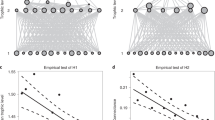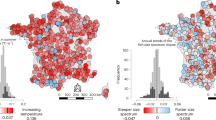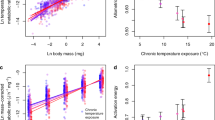Abstract
Natural ecosystems typically consist of many small and few large organisms1,2,3,4. The scaling of this negative relationship between body mass and abundance has important implications for resource partitioning and energy usage5,6,7. Global warming over the next century is predicted to favour smaller organisms8,9,10,11,12, producing steeper mass–abundance scaling13 and a less efficient transfer of biomass through the food web5. Here, we show that the opposite effect occurs in a natural warming experiment involving 13 whole-stream ecosystems within the same catchment, which span a temperature gradient of 5–25 °C. We introduce a mechanistic model that shows how the temperature dependence of basal resource carrying capacity can account for these previously unexpected results. If nutrient supply increases with temperature to offset the rising metabolic demand of primary producers, there will be sufficient resources to sustain larger consumers at higher trophic levels. These new data and the model that explains them highlight important exceptions to some commonly assumed ‘rules’ about responses to warming in natural ecosystems.
This is a preview of subscription content, access via your institution
Access options
Access Nature and 54 other Nature Portfolio journals
Get Nature+, our best-value online-access subscription
$29.99 / 30 days
cancel any time
Subscribe to this journal
Receive 12 print issues and online access
$209.00 per year
only $17.42 per issue
Buy this article
- Purchase on Springer Link
- Instant access to full article PDF
Prices may be subject to local taxes which are calculated during checkout


Similar content being viewed by others
References
Jonsson, T., Cohen, J. E. & Carpenter, S. R. Food webs, body size, and species abundance in ecological community description. Adv. Ecol. Res. 36, 1–84 (2005).
Marquet, P. A., Navarrete, S. A. & Castilla, J. C. Scaling population-density to body size in rocky intertidal communities. Science 250, 1125–1127 (1990).
O’Gorman, E. J. & Emmerson, M. C. Body mass-abundance relationships are robust to cascading effects in marine food webs. Oikos 120, 520–528 (2011).
Reuman, D. C., Mulder, C., Raffaelli, D. & Cohen, J. E. Three allometric relations of population density to body mass: theoretical integration and empirical tests in 149 food webs. Ecol. Lett. 11, 1216–1228 (2008).
Jennings, S. & Blanchard, J. L. Fish abundance with no fishing: predictions based on macroecological theory. J. Anim. Ecol. 73, 632–642 (2004).
White, E. P., Ernest, S. K. M., Kerkhoff, A. J. & Enquist, B. J. Relationships between body size and abundance in ecology. Trends Ecol. Evol. 22, 323–330 (2007).
Woodward, G. et al. Body size in ecological networks. Trends Ecol. Evol. 20, 402–409 (2005).
Daufresne, M., Lengfellner, K. & Sommer, U. Global warming benefits the small in aquatic ecosystems. Proc. Natl Acad. Sci. USA 106, 12788–12793 (2009).
Moran, X. A. G., Lopez-Urrutia, A., Calvo-Diaz, A. & Li, W. K. W. Increasing importance of small phytoplankton in a warmer ocean. Glob. Change Biol. 16, 1137–1144 (2010).
Sheridan, J. A. & Bickford, D. Shrinking body size as an ecological response to climate change. Nat. Clim. Change 1, 401–406 (2011).
Petchey, O. L., McPhearson, P. T., Casey, T. M. & Morin, P. J. Environmental warming alters food-web structure and ecosystem function. Nature 402, 69–72 (1999).
Gardner, J. L., Peters, A., Kearney, M. R., Joseph, L. & Heinsohn, R. Declining body size: a third universal response to warming? Trends Ecol. Evol. 26, 285–291 (2011).
Yvon-Durocher, G., Montoya, J. M., Trimmer, M. & Woodward, G. Warming alters the size spectrum and shifts the distribution of biomass in freshwater ecosystems. Glob. Change Biol. 17, 1681–1694 (2011).
Brown, J. H., Gillooly, J. F., Allen, A. P., Savage, V. M. & West, G. B. Toward a metabolic theory of ecology. Ecology 85, 1771–1789 (2004).
Rice, J. & Gislason, H. Patterns of change in the size spectra of numbers and diversity of the North Sea fish assemblage, as reflected in surveys and models. ICES J. Mar. Sci. 53, 1214–1225 (1996).
Binzer, A., Guill, C., Brose, U. & Rall, B. C. The dynamics of food chains under climate change and nutrient enrichment. Phil. Trans. R. Soc. B 367, 2935–2944 (2012).
Fussmann, K. E., Schwarzmüller, F., Brose, U., Jousset, A. & Rall, B. C. Ecological stability in response to warming. Nat. Clim. Change 4, 206–210 (2014).
DeLong, J. P. Experimental demonstration of a ‘rate–size’ trade-off governing body size optimization. Evol. Ecol. Res. 14, 343–352 (2012).
Reuman, D. C., Holt, R. D. & Yvon-Durocher, G. A metabolic perspective on competition and body size reductions with warming. J. Anim. Ecol. 83, 59–69 (2014).
Adams, G. et al. Diatoms can be an important exception to temperature-size rules at species and community levels of organization. Glob. Change Biol. 19, 3540–3552 (2013).
Friberg, N. et al. Relationships between structure and function in streams contrasting in temperature. Freshwat. Biol. 54, 2051–2068 (2009).
O’Gorman, E. J. et al. Impacts of warming on the structure and function of aquatic communities: individual- to ecosystem-level responses. Adv. Ecol. Res. 47, 81–176 (2012).
Woodward, G. et al. Sentinel systems on the razor’s edge: effects of warming on Arctic geothermal stream ecosystems. Glob. Change Biol. 16, 1979–1991 (2010).
Demars, B. O. L. et al. Temperature and the metabolic balance of streams. Freshwat. Biol. 56, 1106–1121 (2011).
O’Gorman, E. J. et al. Climate change and geothermal ecosystems: natural laboratories, sentinel systems, and future refugia. Glob. Change Biol. 20, 3291–3299 (2014).
Gilbert, B. et al. A bioenergetic framework for the temperature dependence of trophic interactions. Ecol. Lett. 17, 902–914 (2014).
Welter, J. R. et al. Does N2-fixation amplify the temperature dependence of ecosystem metabolism? Ecology 96, 603–610 (2015).
Battin, T. J. et al. Biophysical controls on organic carbon fluxes in fluvial networks. Nat. Geosci. 1, 95–100 (2008).
Brookshire, E., Valett, H. & Gerber, S. Maintenance of terrestrial nutrient loss signatures during in-stream transport. Ecology 90, 293–299 (2009).
Elliott, J. & Elliott, J. Temperature requirements of Atlantic salmon Salmo salar, brown trout Salmo trutta and Arctic charr Salvelinus alpinus: predicting the effects of climate change. J. Fish Biol. 77, 1793–1817 (2010).
O’Gorman, E. J. et al. Temperature effects on fish production across a natural thermal gradient. Glob. Change Biol. 22, 3206–3220 (2016).
Kratina, P., Greig, H. S., Thompson, P. L., Carvalho-Pereira, T. S. & Shurin, J. B. Warming modifies trophic cascades and eutrophication in experimental freshwater communities. Ecology 93, 1421–1430 (2012).
IPCC Climate Change 2013: The Physical Sciences Basis (eds Stocker, T. F. et al.) 36 (Cambridge Univ. Press, 2013).
Stewart, B. A., Close, P. G., Cook, P. A. & Davies, P. M. Upper thermal tolerances of key taxonomic groups of stream invertebrates. Hydrobiologia 718, 131–140 (2013).
Nelson, D. et al. Experimental whole-stream warming alters community size structure. Glob. Change Biol. 23, 2618–2628 (2017).
Gudmundsdottir, R. et al. Effects of temperature regime on primary producers in Icelandic geothermal streams. Aquat. Bot. 95, 278–286 (2011).
Hannesdóttir, E. R., Gíslason, G. M., Ólafsson, J. S., Ólafsson, Ó. P. & O’Gorman, E. J. Increased stream productivity with warming supports higher trophic levels. Adv. Ecol. Res. 48, 283–340 (2013).
Arnason, B., Theodorsson, P., Björnsson, S. & Saemundsson, K. Hengill, a high temperature thermal area in Iceland. Bull. Volcanol. 33, 245–259 (1969).
Abramoff, M. D., Magalhaes, P. J. & Ram, S. J. Image processing with ImageJ. Biophotonics Int. 11, 36–42 (2004).
Sun, J. & Liu, D. Geometric models for calculating cell biovolume and surface area for phytoplankton. J. Plankton Res. 25, 1331–1346 (2003).
Rocha, O. & Duncan, A. The relationship between cell carbon and cell volume in freshwater algal species used in zooplanktonic studies. J. Plankton Res. 7, 279–294 (1985).
Sicko-Goad, L. M., Schelske, C. L. & Stoermer, E. F. Estimation of intracellular carbon and silica content of diatoms from natural assemblages using morphometric techniques. Limnol. Oceanogr. 29, 1170–1178 (1984).
Seber, G. A. F. & Le Cren, E. D. Estimating population parameters from catches large relative to the population. J. Anim. Ecol. 36, 631–643 (1967).
Zuur, A. F., Ieno, E. N., Walker, N. J., Saveliev, A. A. & Smith, G. M. Mixed Effects Models and Extensions in Ecology with R 101–142 (Springer, 2009).
Damuth, J. Population-density and body size in mammals. Nature 290, 699–700 (1981).
Jennings, S. & Mackinson, S. Abundance–body mass relationships in size-structured food webs. Ecol. Lett. 6, 971–974 (2003).
Yodzis, P. & Innes, S. Body size and consumer-resource dynamics. Am. Nat. 139, 1151–1175 (1992).
Vasseur, D. A. & McCann, K. S. A mechanistic approach for modeling temperature-dependent consumer-resource dynamics. Am. Nat. 166, 184–198 (2005).
Acknowledgements
We thank J. Reiss for meiofauna and protist data, N. Craig for laboratory work, A. Moustakas for advice on data analysis, G. M. Gíslason and J. S. Ólafsson for providing research support and facilities, and G. Yvon-Durocher, S. Pawar, M. Trimmer and B. Kordas for helpful comments on earlier drafts. We acknowledge funding from NERC (NE/I009280/2, NE/F013124/1, NE/L011840/1, NE/M020843/1), the Royal Society (RG140601), the British Ecological Society (4009-4884), the National Special Water Program (No. 2009ZX07210-009), the China Scholarship Council (No. 201206730022), the Department of Environmental Protection of Shandong Province (SDHBPJ-ZB-08), the German Research Foundation (FZT 118), the James S. McDonnell Foundation, and NSF (1442595).
Author information
Authors and Affiliations
Contributions
G.W., N.F. and D.C.R. were responsible for funding application, research design, and planning. E.J.O’G., D.E.P., G.A. and A.S. collected the data. E.J.O’G., B.C.R. and L.Z. analysed the data. L.Z., D.C.R. and H.Z. did the modelling. All authors wrote the paper.
Corresponding authors
Ethics declarations
Competing interests
The authors declare no competing financial interests.
Supplementary information
Supplementary Information
Supplementary Information (PDF 2417 kb)
Rights and permissions
About this article
Cite this article
O’Gorman, E., Zhao, L., Pichler, D. et al. Unexpected changes in community size structure in a natural warming experiment. Nature Clim Change 7, 659–663 (2017). https://doi.org/10.1038/nclimate3368
Received:
Accepted:
Published:
Issue Date:
DOI: https://doi.org/10.1038/nclimate3368
This article is cited by
-
Body size induced changes in metabolic carbon of soil nematodes under N deposition and precipitation regime change in a temperate grassland
Ecological Processes (2024)
-
Steeper size spectra with decreasing phytoplankton biomass indicate strong trophic amplification and future fish declines
Nature Communications (2024)
-
Regional impacts of warming on biodiversity and biomass in high latitude stream ecosystems across the Northern Hemisphere
Communications Biology (2024)
-
Human pressures modulate climate-warming-induced changes in size spectra of stream fish communities
Nature Ecology & Evolution (2023)
-
Chronic exposure to environmental temperature attenuates the thermal sensitivity of salmonids
Nature Communications (2023)



